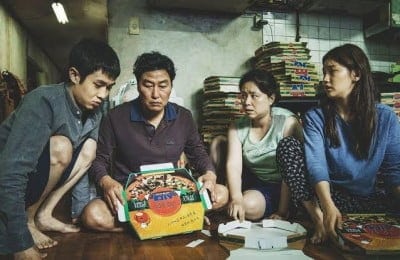Assuming you have already watched this Academy award-winning masterpiece, read further to unravel not-so-subtle imagery of class hierarchy in modern society.
Warning: Spoilers Ahead
It is not easy to describe or critique a movie like Parasite. It is a satirical, drama-thriller. Like its father, Bong Joon-ho, the movie is highly dynamic as it changes tones like a girl changes clothes (Hot N Cold reference). Bong creates a tapestry depicting class hierarchy via his craft of interweaving various subtle as well as not-so-subtle threads.
The movie opens with the Kim family son, Ki-woo, walking around their tiny house in search of Wi-Fi connection. The toilet happens to be the highest point in the house apparently giving him the connection to a network that probably isn’t password-protected, basically leeching off some neighbour. Evidently, the parasitical attributes of the family are established very early in the film. We also see how the family lives in a semi-basement. Semi-basement means that the house is also semi-over ground essentially giving the family a sense of hope as well.
A little further into the movie we see the Park family house located on some sort of a hilltop. Later we also learn how Moon-gwang and Geun-sae live in an even lower basement in the Park house. Bong uses this element of “upstairs and downstairs” to establish the positions of these families in the class hierarchies. The same concept is used in multiple ways further in the film.
Watching the movie, you realise that this isn’t just a fight between two families from different social backgrounds, but also between two families from the same background. Instead of coexistence, the idea of “survival of the fittest” is somewhat adopted. Eventually, after all the ruckus and drama, the Kim family manages to put Geun-sae and Moon-gwang back to where they really “belong”- the lowest basement.
Right after this we also see the Kim family hiding under the living room table as soon as they hear the owners of the house return; just like how cockroaches hide under small spaces in fear of getting caught and killed. As soon as the family seems to be asleep, they run and escape at their first chance, back to their original “hole”.
Water happens to play a rather significant role throughout the film. Initially, we see a man urinating outside the Kims’ window. They try to fight him away by throwing water at him, which only turns everything messier. Later in the movie, we see how the Kim basement is flooded with sewage water after heavy rainfall. Clearly, water hasn’t been their best friend after all. The flooded basement also gives a push to a domino effect which is to follow.
When the family is called back to work the next day, which is a weekend, a blatant tension can be sensed, best expressed by Ki-taek (Kang-Ho Song). While Ki-taek is driving Yeon-kyo back home from the market, we see her talk to a friend on a call about how the rain had been a blessing clearing up the sky of pollution. We learn how the rain has different effects on people from different classes. While it dragged one family out of their house, it pulled back another from a camping trip, only to appreciate the house more.
The movie reaches its climax when Gyun-sae manages to set himself free and runs up to attack, first Ki-woo, and next his sister Ki-jung. When Ki-taek kills Gyun-sae and tries to save his daughter, Park Dong-ik just asks him to abandon his own family and drive them away. This simply shows how little he cared about the “lower” class family, yet again creating a class division.
Out of frustration, killing Dong-ik, Ki-taek hides in the very place he wished to escape- the lowest basement. He became what he was trying to get rid of. The Park family left the house giving way to yet another rich German family to take their place. No matter what, a richer family will always be above Ki-taek, leaving him to remain a mere parasite.
With Ki-jung dead, Ki-woo and Chung-sook return to their original places in the semi-basement. When Ki-woo decodes a message from his father, he pledges to work hard his entire life until he is able to buy the house, and then all Ki-taek needs to do is “walk upstairs”. We even see the family reuniting, but Bong shoots his final bullet as a sure-fire, bringing Ki-woo back in his home to let his audience know that life isn’t so convenient, and his aspirations can never really turn to reality. This again reflects a very realistic image.
Why Parasite is adored throughout the world is because this same plot which is set in South Korea could have been set in New York or London or even New Delhi. Class division is a universal concept and affects each one of us in one way or the other.
Feature Image Credit: CJ Entertainment
Aditi Gutgutia

